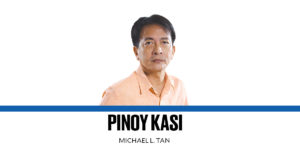How much would you need for groceries if you lived in Manila in 1674? Answering the question was not as simple as I thought, because it required as much imagination as historical research.
First, Manila was a far cry from the Metro Manila we know today. The “distinguished and ever loyal city” was confined to the area inside (intra) the walls (muros). Cash, credit cards, ATMs, pasa-load, and GCash were way beyond anyone’s wildest dreams. Cash was always short, especially for small day-to-day transactions, forcing people to resort to barter, or the exchange of goods and services without money.
With barter, staples like yam and unthreshed rice served as a medium of exchange. In later centuries, with the establishment of the Tobacco Monopoly in 1782, cigars rose to become a medium of exchange, too, and could be used, like rice, to pay tribute and taxes.
A handful of palay counted as one monetary unit, increasing from 1 to 100, or even a thousand handfuls. How many handfuls of palay were needed in exchange for a chicken? Or when did people stop counting handfuls of palay and shifted to husked rice or bigas by weight or volume? Barter must have been so fluid and confusing that prices had to be determined and regulated by the cabildo or municipal council of Manila. Prices were based on the value of “tostones,” also known as “macuquinas,” or cobs minted in Mexico and transported to Manila on the fabled galleons that connected Manila and Acapulco from 1565-1815.
What was taught to me in high school and college was that the search for spices brought the Portuguese and Spanish to Asia, but what was left out of the story was the insatiable demand for silver in China. So the galleons left Mexico heavy with silver from Spanish America, unloaded and traded for Chinese goods in Manila, then shipped on to China. Because the galleons returning to Mexico groaned with Chinese goods, they were also known as “La Nao de la China” (China ship), but we Filipinos call them the Manila Galleon. Haven’t we changed the name of the disputed maritime territory from South China Sea to West Philippine Sea? Younger people learn a slightly different history today: the story of silver sourced in Spanish America, loaded in Mexico, unloaded in Manila, and exchanged for Chinese goods — this was, in the 16th century, the first globalization.
Cobs were irregularly shaped pieces of silver, hammer-stamped with a cross on one side and the Spanish coat of arms on the other as a guarantee of their weight, fineness, and authenticity. In antique shops today, these are known as “hilis kalamay.” Since the value of one hilis kalamay exceeded ordinary, day-to-day expenses, these were cut up, like rice cakes (kalamay), and the “monedas cortadas” (cut money) pieces came to be known under different names. A whole hilis kalamay was also known as salapi, our present term for money. A salapi cut in half resulted in two “kalahati.” A salapi cut into four produced “sikapat” or quarters. A salapi cut into eight produced “sikolos” or eighths.
To provide for much needed fractional currency, copper coins or “maravedis” were struck in Spain for circulation in the overseas empire. Even these were not enough for use in Manila, so the cabildo authorized the circulation of barillas, the earliest Philippine coins. Digging up material on these rare coins, I found out that these were originally cut from “barretas” or copper bars, giving rise to the term barillas that was later corrupted into “barya,” the current Filipino word for fractional currency, crudely struck small-value copper coins, or small change.
One source even mentioned that the earliest barillas were not round and coin-shaped but were like a parallelogram! None of the coin collectors I consulted for this column have ever seen a copper barretas or barilla in the shape of a parallelogram. They all agreed that the earliest minted barillas dated back to 1728. Nobody could explain why barillas are mentioned, together with reales, in the 1674 Arancel or prices regulated by the Cabildo de Manila.
Beyond the numismatic or collector’s value of old coins like hilis kalamay and barillas, what could this money buy before? I regret tuning out of college economics class, because our professor revered the thick economics textbook by Paul Samuelson like the bible, but failed to engage his bored students by relating the graphs and economic principles to current Philippine conditions — as Ciel Habito, Winnie Monsod, and Peter Wallace do in their Inquirer columns.
Comments are welcome at aocampo@ateneo.edu


